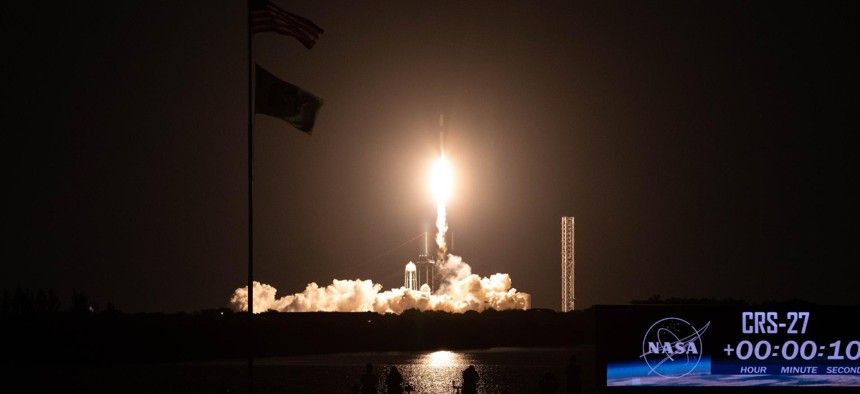Naval Research Lab Launches First In-Space Laser Energy Experiment

The SpaceX Falcon 9 rocket carrying the Dragon spacecraft lifts off from Launch Complex 39A at NASA’s Kennedy Space Center in Florida on March 14, 2023, on the company’s 27th commercial resupply services mission for the agency to the International Space Station. NASA/Kim Shiflett
The experiment will demonstrate using power beaming technology to deliver instant energy in space.
The U.S. Naval Research Laboratory launched the Space Wireless Energy Laser Link—or SWELL—late Tuesday to demonstrate laser power beaming in space as part of a scheduled Defense Department Space Test Program H9 mission to the International Space Station, according to an agency announcement.
The SWELL experiment was launched aboard the SpaceX Dragon cargo vehicle to the ISS to “collect data during a laser power beaming link in space conditions.” According to the announcement, power beaming is a way to deliver energy in the form of electromagnetic waves that do not require transporting mass alongside them, so energy can be sent almost instantaneously. This method has been proven achievable on the ground and is now being tested in space. Specifically, it will explore the challenges for power beaming and its viability in space applications, as well as highlight the possibilities for using power beaming to address Earth’s energy challenges.
SWELL is one of many experiments on the SpaceX Dragon vehicle. The experiment is sponsored by the Office of the Under Secretary of Defense for Acquisition and Sustainment and supported by the Operational Energy Capability Improvement Fund.
“With this modest experiment, we will identify key focus areas for developing links of greater power and longer distance for space,” said Paul Jaffe, electronics engineer and SWELL principal investigator. “By employing laser transmitters and photovoltaic receivers, power beaming links will be established that will pave the way for rapid, resilient and flexible energy delivery systems.”
The yearlong SWELL experiment should provide data showing how the hardware functions in space and the constraints likely to affect the future operational system deployments.
“Power beaming might also be used for distributing power for and around Earth, including from satellites that collect solar energy in space,” Jaffe said. “SWELL is the next step into this new frontier.”
According to the announcement, SWELL could be a good option to demonstrate the potential uses of lunar resources and development on the Moon because it removes the need for fuel, batteries or stringing wires.
“This is the next step in extending this capability for space, lunar and planetary applications,” Chris DePuma, SWELL program manager, said. “Power beaming is poised as a critical enabler for power distribution on the moon and elsewhere in space.”
NEXT STORY: CFPB Announces New Inquiry into Data Brokers




